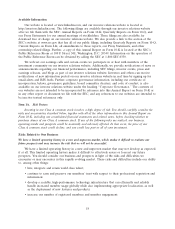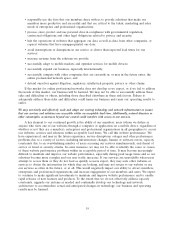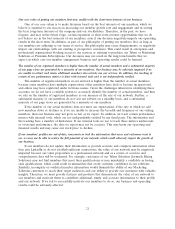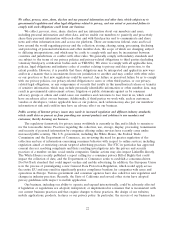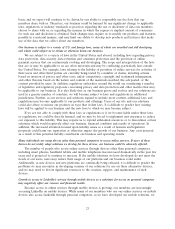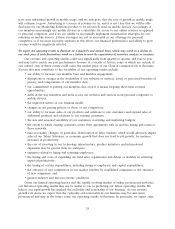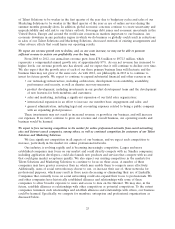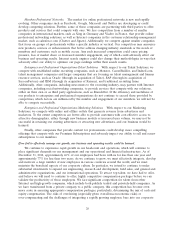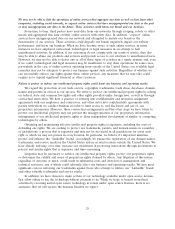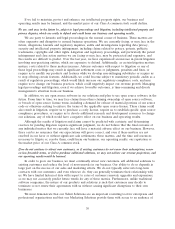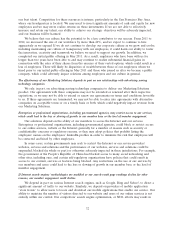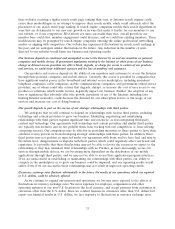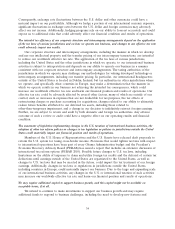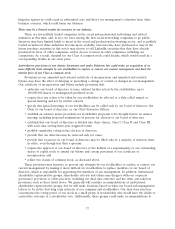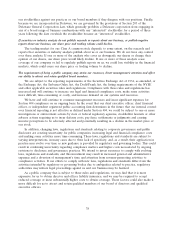LinkedIn 2012 Annual Report Download - page 30
Download and view the complete annual report
Please find page 30 of the 2012 LinkedIn annual report below. You can navigate through the pages in the report by either clicking on the pages listed below, or by using the keyword search tool below to find specific information within the annual report.• increased competition from local websites and services, that provide online professional networking
solutions, such as Germany-based Xing and France-based Viadeo, and online recruitment services,
such as Australia-based Seek and Japan-based Recruit, who have and may continue to expand their
geographic footprint;
• differing and potentially lower levels of member growth and engagement in new and nascent
geographies;
• compliance with applicable foreign laws and regulations, including potential risk of penalties to
individual members of management if our practices are deemed to be out of compliance;
• longer payment cycles in some countries;
• credit risk and higher levels of payment fraud;
• compliance with anti-bribery laws including, without limitation, compliance with the Foreign
Corrupt Practices Act and the UK Anti-Bribery Act;
• currency exchange rate fluctuations;
• foreign exchange controls that might prevent us from repatriating cash earned outside the United
States;
• foreign exchange controls that might require significant lead time in setting up operations and bank
accounts before monetizing certain geographic territories;
• political and economic instability in some countries, specifically in Ireland;
• double taxation of our non-U.S. earnings and potentially adverse tax consequences due to changes
in the tax laws of the United States or the foreign jurisdictions in which we operate; and
• higher costs of doing business internationally.
If our revenue from our international operations, and particularly from our operations in the
countries and regions on which we have focused our spending, do not exceed the expense of establishing
and maintaining these operations, our business and operating results will suffer. In addition, as our
member base expands internationally, members in certain geographies may have lower levels of
engagement with our website and services.
Our business depends on a strong and trusted brand, and any failure to maintain, protect and enhance our
brand would hurt our ability to retain or expand our base of members, enterprises and professional
organizations, our ability to increase their level of engagement and our ability to attract and retain high level
employees.
We have developed a strong and trusted brand that we believe has contributed significantly to the
success of our business. Our brand is predicated on the idea that individual professionals will trust us and
find immense value in building and maintaining their professional identities and reputations on our
platform. If our members or potential members determine that they can use other platforms, such as
social networks, for the same purposes as or as a replacement for our network, or if they choose to blend
their professional and social networking activities, our brand and our business could be harmed.
Maintaining, protecting and enhancing the ‘‘LinkedIn’’ brand is critical to expanding our base of members,
enterprises, advertisers, corporate customers and other partners, and increasing their engagement with our
services, and will depend largely on our ability to maintain member trust, be a technology leader and
continue to provide high-quality solutions, which we may not do successfully. For example, members or
customers could find that new products or features that we introduce are difficult to use or may feel that
they degrade their experience on LinkedIn, which could harm our reputation for delivering high-quality
products. Our brand is also important in attracting and maintaining high performing employees. If we do
not successfully maintain a strong and trusted brand, our business could be harmed.
28


